The Sandy Bridge Review: Intel Core i7-2600K, i5-2500K and Core i3-2100 Tested
by Anand Lal Shimpi on January 3, 2011 12:01 AM EST3D Rendering Performance
Today's desktop processors are more than fast enough to do professional level 3D rendering at home. To look at performance under 3dsmax we ran the SPECapc 3dsmax 8 benchmark (only the CPU rendering tests) under 3dsmax 9 SP1. The results reported are the rendering composite scores.
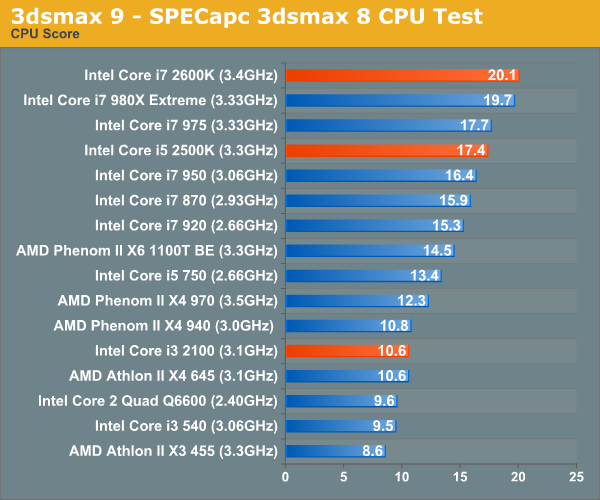
At the risk of sounding like a broken record, we have a new champ once more. The 2600K is slightly ahead of the 980X here, while the 2500K matches the performance of the i7 975 without Hyper Threading enabled. You really can't beat the performance Intel is offering here.
The i3 2100 is 11% faster than last year's i3 540, and the same performance as the Athlon II X4 645.
Created by the Cinema 4D folks we have Cinebench, a popular 3D rendering benchmark that gives us both single and multi-threaded 3D rendering results.
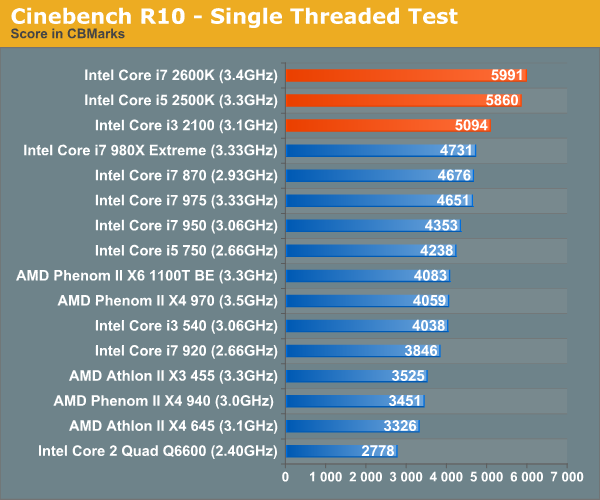
Single threaded performance sees a huge improvement with Sandy Bridge. Even the Core i3 2100 is faster than the 980X in this test. Regardless of workload, light or heavy, Sandy Bridge is the chip to get.
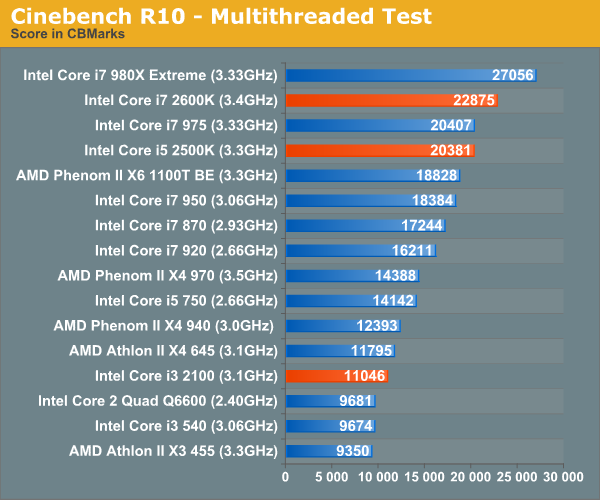
POV-Ray is a popular, open-source raytracing application that also doubles as a great tool to measure CPU floating point performance.
I ran the SMP benchmark in beta 23 of POV-Ray 3.73. The numbers reported are the final score in pixels per second.
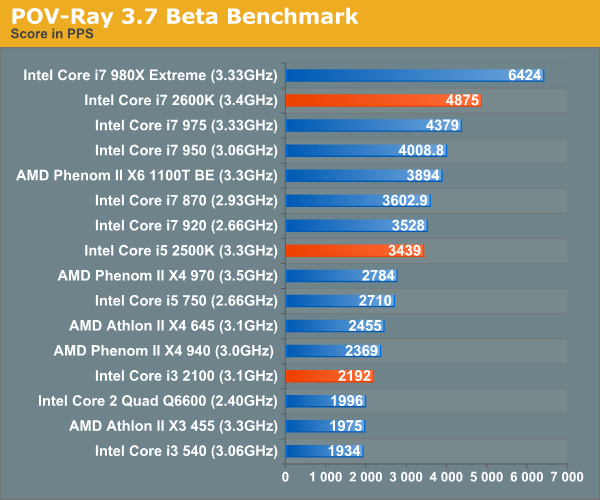
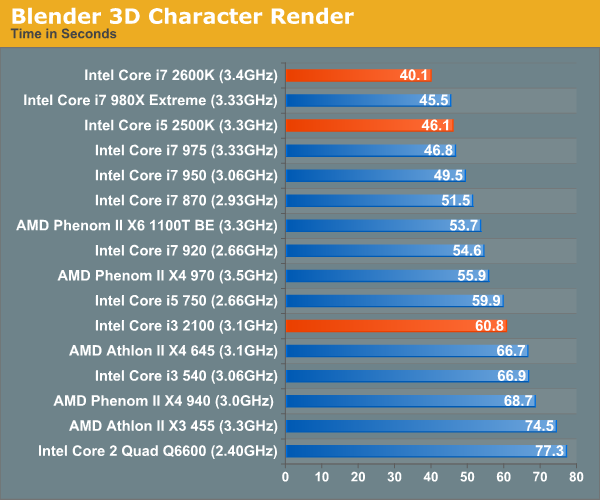










283 Comments
View All Comments
CreativeStandard - Monday, January 3, 2011 - link
PC mag reports these new i7's only support up to 1333 DDR3 but you are running faster, is PC mag wrong, what is the maximum supported memory speeds?Akv - Monday, January 3, 2011 - link
Is it true that it has embedded DRM ?DanNeely - Monday, January 3, 2011 - link
Only to the extent that like all intel Core2 and later systems it supports a TPM module to allow locking down servers in the enterprise market and that the system *could* be used to implement consumer DRM at some hypothetical point in the future; but since consumer systems aren't sold with TPM modules it would have no impact on systems bought without.shabby - Monday, January 3, 2011 - link
Drm is only on the h67 chipset, and its basically just for watching movies on demand and nothing more.Akv - Monday, January 3, 2011 - link
Mmmhh... ok...Nevertheless the intel HD + H67 was already modest, if it has DRM in addition then it becomes not particularly seducing.
marraco - Monday, January 3, 2011 - link
Thanks for adding Visual Studio compilation benchmark. (Although you omitted the 920).It seems that not even SSD, nor can better processors do much for that annoying time waster. It does not matter how much money you throw at it.
I wish to see also SLI/3-way SLI/crossfire performance, since the better cards frequently are CPU bottlenecked. How much better it does relative to i7 920? And with good cooler at 5Ghz?
Note: you mention 3 video cards on test setup, but what one is on the benchmarks?
Anand Lal Shimpi - Monday, January 3, 2011 - link
You're welcome on the VS compile benchmark. I'm going to keep playing with the test to see if I can use it in our SSD reviews going forward :)I want to do more GPU investigations but they'll have to wait until after CES.
I've also updated the gaming performance page indicating what GPU was used in each game, as well as the settings for each game. Sorry, I just ran out of time last night and had to catch a flight early this morning for CES.
Take care,
Anand
c0d1f1ed - Monday, January 3, 2011 - link
I wonder how this CPU scores with SwiftShader. The CPU part actually has more computing power than the GPU part. All that's lacking to really make it efficient at graphics is support for gather/scatter instructions. We could then have CPUs with more generic cores instead.aapocketz - Monday, January 3, 2011 - link
I have read that CPU overclock is only available on P67 motherboards, and H67 motherboards cannot overclock the CPU, so you can either use the onboard graphics OR get overclocking? Is this true?"K-series SKUs get Intel’s HD Graphics 3000, while the non-K series SKUs are left with the lower HD Graphics 2000 GPU."
whats the point of improving the graphics on K series, if pretty much everyone who gets one will have a P67 motherboard which cannot even access the GPU?
Let me know if I am totally not reading this right...
MrCromulent - Monday, January 3, 2011 - link
Great review as always, but on the HTPC page I would have wished for a comparison of the deinterlacing quality of SD (480i/576i) and HD (1080i) material. Ati's onboard chips don't offer vector adaptive deinterlacing for 1080i material - can Intel do better?My HD5770 does a pretty fine job, but I want to lose the dedicated video card in my next HTPC.